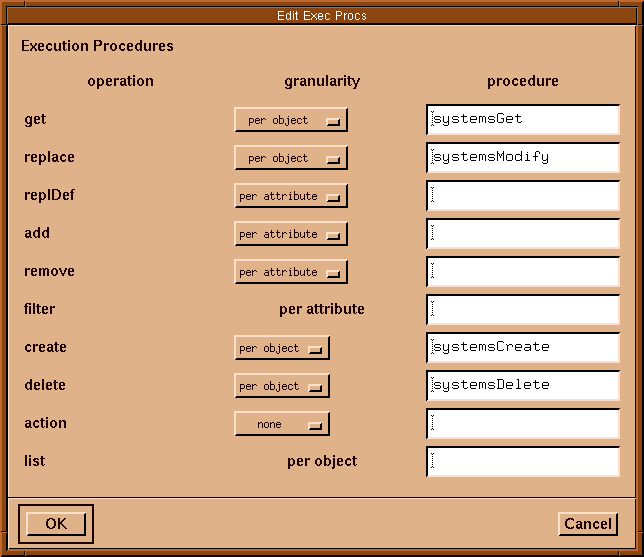Step 5: Define the execution procedures
The execution procedure dialog is accessed via the
Exec Procs... button. After making your
selections, select Generate Procs from the File
menu to generate a file containing execution procedure declarations.
Refer to
``About execution procedures''
for an explanation of the each function.
``Execution Procedures screen''
has get, replace, create, and delete procedures defined.

Execution Procedures screen
-
The interface does not create the actual execution procedures,
it merely generates a file with stubs that can be edited and
filled out later.
-
Each procedure is preceded by a comment
that describes the function's purpose, arguments, and return
values. If you make changes in your class that change the
execution procedures, you may want to create a new procedure
file and merge in the new stubs with your original procedure file.
-
If the text widget for an operation is grayed out, a procedure is not
needed. Option menus allow you to choose per-attribute or per-object
processing on the attribute operations, and allow you to choose whether
to implement each object operations. The procedure text fields will be
filled in with a default name if the operation needs to be implemented but
you have not chosen a procedure name yet.
-
For the three per-object operations, it is up to you whether to
implement them or not. For the action operation, you must determine what
actions are valid for your class, although this is not specified in the
class definition. Actions are defined in the actual code itself.
-
Default names are provided for each procedure. It is sometimes useful
to have one procedure handle multiple operations, or even the same
operation on multiple classes within an OSA.
Next topic:
About execution procedures
Previous topic:
Step 4: Grouping attributes
© 2005 The SCO Group, Inc. All rights reserved.
SCO OpenServer Release 6.0.0 -- 03 June 2005

